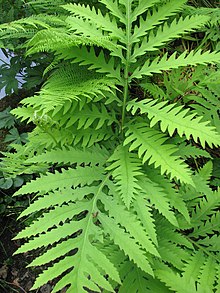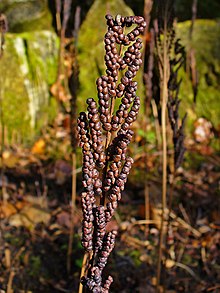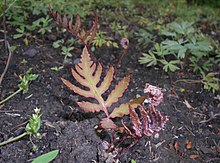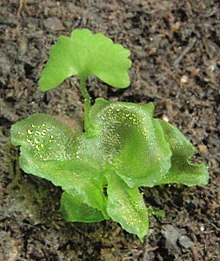| Onoclea sensibilis | |
|---|---|

| |
| Conservation status | |
 Secure (NatureServe) | |
| Scientific classification | |
| Kingdom: | Plantae |
| Clade: | Tracheophytes |
| Division: | Polypodiophyta |
| Class: | Polypodiopsida |
| Order: | Polypodiales |
| Suborder: | Aspleniineae |
| Family: | Onocleaceae |
| Genus: | Onoclea |
| Species: | O. sensibilis |
| Binomial name | |
| Onoclea sensibilis L. | |
Onoclea sensibilis, the sensitive fern, also known as the bead fern, is a coarse-textured, medium to large-sized deciduous perennial fern. The name comes from its sensitivity to frost, the fronds dying quickly when first touched by it. It is sometimes treated as the only species in Onoclea, but some authors do not consider the genus monotypic.
Description
The sterile and fertile fronds of Onoclea sensibilis have independent stalks originating from the same rhizome, quite different from other ferns. The bright, yellow-green trophophylls (sterile fronds) are deeply pinnatifid and are typically borne at intervals along the creeping rhizome. The sterile fronds are deciduous with trophopods, swollen bases, that serve as over winter storage organs. The sterile fronds of O. var. sensibilis have a length of 1–1.3 m (3.3–4.3 ft) with 5–11 pinnae, leaf pairs, evenly spaced along the stipe. O. var. interrupta Maxim. fronds are shorter, 20–50 cm (7.9–19.7 in) long, with fewer pinnae, only 5–8 pairs.

The sporophylls (fertile fronds) are smaller, 20–45 cm (7.9–17.7 in) in length, non-green at maturity and have very narrow pinnae. They are persistent, standing 2–3 years. The sori comprise clusters of sporangia (spore cases) 2–4 mm (1/10–1/6 in) in diameter, like beads, on upright fertile fronds, hence the common name Bead fern.
Sori are typically bilaterally symmetrical, though leaf forms have been observed with pinnae fertile only on a single side of the rachis. This form, named O. sensibilis L. F. hemiphyllodes (Kiss & Kümmerle, 1926) and a second, O. sensibilis L. F. obtusilobata having flat pinnules (not curled or bead shaped), were deemed to be variations not meriting taxonomic recognition (J. M. Beitel et al. 1981).

The fiddleheads have a pale reddish color.
Morphology
The spermatogenesis process spans formation of spermatogenous cells to the release of spore. In homosporous ferns, like O. sensibilis L., developing spermatids are surrounded by two different walls at specific development stages, as opposed to a single wall reported in other species. Other differences include a delayed formation of the osmiophilic crest and during sperm release the cap cell removes intact, as opposed to forming a pore or collapsing altogether. Spores are monolete with the antheridium, or sporangium, containing either 32 or 64 sperm spores, usually being 64. Regardless of the number, the capsule's volume remains nearly the same.
The mechanics of spore release and its timing are controlled by springtime humidity. The small fertile margins, that in live-form held spore in tightly rolled structures, maintain their dry, leathery shape over winter. These pinnules respond to spring's higher humidity by opening, releasing their spore into the air. Subsequent gametophytes are unisexual in early development, favoring cross-fertilization, later becoming bisexual to ensure species survival.
Taxonomy
Taxonomic history
Species
The genus Onoclea was cast by Carl Linnaeus in 1751, separating from the fern's prior association with the Angiopteris genus. The binominal name, Onoclea sensibilis, was published in his 1753 Species Plantarum.
Varieties
Onoclea sensibilis has two geographically disjunctive varieties. Onoclea sensibilis var. sensibilis is native to North America; Canada's central and eastern regions and the United States' north, central and eastern regions. Onoclea sensibilis var. interrupta Maximowicz (aka Maxim.) is native to Southeast Siberia, Japan and China. The varietal difference is their ultimate height, O. var. interrupta Maxim. only reaching half the height of its sister.
Alternate names
Regional colloquial names for Onoclea sensibilis, the sensitive fern, focus on its characteristics.
- bead fern, an alternate name based on its fertile beaded pinnae (leaflets)
- bolletjesvaren; Dutch, meaning "ball fern"
- druebregne; Danish, meaning "grape fern"
- dwa’hũdes gananitsga’kwaʼ; Cayuga, meaning "deer, what they lie on"
- harilik pärljalg; Estonian, meaning "common pearl leg"
- helmisaniainen; Finnish, meaning "mother of pearl"
- pärlbräken; Swedish, meaning "pearl bracts"
- unì·suwεkwaʼ; Onondaga, meaning "bait"
Etymology
Onoclea sensibilis' name was descriptive. Onoclea comes from the Greek onos, meaning a vessel, and kleio, meaning to close, describing the closely rolled sori on its fertile fronds. Its species, from the Late Latin sensibilis, means sensitive, describing its high sensitivity to autumn's first frost and to drought.
Distribution and habitat
Onoclea sensibilis is native to Northern Hemisphere temperate regions; the Russian Far East, China and Eastern Asia, and a wide native distribution in Northern America. It ranges from Newfoundland south to Florida and west to Texas, the Rocky Mountains, North and South Dakota, Quebec, and Manitoba.
It has become naturalized in western Europe and New Zealand.
Onoclea sensibilis can be found at elevations from sea level up to 1,500 metres (4,900 ft) in fresh water habitats, not brackish, as its spore germination ceases at salt (NaCl) levels ≥ 0.6%, moderately saline water and higher.
Onoclea sensibilis grows best in moist shaded or partially shaded areas, dwelling in a variety of swamp and wood habitats: wet meadows, thickets and bogs, as well as stream and riverbanks and roadside ditches. It tolerates extremely wet soils, appearing in soggy ground or at the very edge of water in shade or sun. The plant can tolerate dryer conditions in shade.
It prefers acidic (pH <6.8), loose, sandy to loam, limestone-based soils.
Ecology

The Onoclea sensibilis plant has remained essentially unchanged over millions of years. A fifty-seven million year old fossil of Paleocene epoch flora shows specimens virtually identical to modern samples. It has a life cycle featuring alternation of generations, sexual and asexual reproduction; its sporophyte generation matures in autumn, casts its spores in the spring and the gametophyte generation follows. Sporophytes require 5–10 years of growth before reaching their mature fern height.
Sensitive ferns propagate by both spore dispersion and rhizome growth. Its growth clusters attract local fauna where small wildlife find habitat, deer bed upon its dense mat and in winter wild turkeys use the fertile spore stalks as a secondary food source. They can become aggressive and a nuisance if established near preferable vegetation. The University of Maine's Cooperative Extension: Maine Wild Blueberries classifies the sensitive fern as a herbaceous broadleaf weed.
Its deciduous fronds do not tolerate freezing temperatures, however, the plant survives USDA hardiness zones 4–8, or minimum temperatures of −20 to −15 °C (−4 to 5 °F) having the Royal Horticultural Society's H6 rating. Winter survival is enhanced if the dried frond petiole bases are left intact.
Nutrient beneficial ectotrophic mycorrhizal associations may occur in Onoclea sensibilis, Pteridium aquilinum and Adiantum pedatum located in oak and hickory forests.
Onoclea sensibilis is a wetland indicator, listed as a Facultative Wetland Hydrophyte in the 2013 (US) National Wetland Plant List due to its observed affinity for wetter soils.
Opinion is mixed regarding the species' tolerance to disturbance of its growing environment. In one forest setting, a decade long decline was noticed following even single-cut tree felling operations. In other settings sensitive ferns appear opportunistic, disturbance not being a problem. They spread to form colonies, often the first species to inhabit disturbed areas.
Pests and diseases
Onoclea sensibilis hosts insects, fungi, bacteria and even a parasitic vine, Cuscuta gronovii (scaldweed), that can overgrow and constrict it.

Insects
Insects feeding upon the Onoclea sensibilis target both its leaves and rhizome roots. Amphorophora ampullata fern aphids, Chirosia gleniensis fern miners and the larvae of sawflies Hemitaxonus dubitatus and Stromboceros delicatulus feed on its leaves. Larvae of moth species Phlogophora iris (olive angle shades, pictured), Callopistria cordata (silver-spotted fern moth) and Papaipema inquaesita (Sensitive Fern Borer) are known to feed on both stems and rhizomes.
Fungi
Parasitic fungi include Ceratobasidium anceps, causing frond and stem necrosis; Ceratobasidium cornigerum, covering stems with saprophyte growths; and Uredinopsis mirabilis, a distinct rust species unique to the Sensitive Fern. Invasive fungi like Taphrina filicina, Taphrina hiratsukae and Phyllactinia corylea, synonym Phyllactinia guttata can infect leaves, causing blisters or white powdery mildew.
Fungi can develop beneath beech trees, where aphid honeydew secretions accumulate; these strictly epiphyllous honeydew fungi, Sclerotiomyces colchicus and Scorias spongiosa (Schwein.) Fr., have been recorded on Onoclea sensibilis, where their sooty mold buildup impairs leaf function.
Bacteria
Onoclea sensibilis can host Burkholderia plantarii which causes stem lesions. B. plantarii is a pathogen of bacterial seedling blight in rice. In a multi-year study the weedy presence of O. sensibilis at rice paddy fields and a means to convey the bacterium (rainfall runoff) implicated it as the source of bacterial blight outbreaks when paired with enabling environmental conditions.
Toxicity
Pharmacology
Onoclea sensibilis has two internally-synthesized chemical defenses against insects. Ingesting any part of the plant introduces thiaminase enzymes and phytoecdysteroid hormones which can disrupt an insect's molting cycle, preventing its full development.
Mammal
Onoclea sensibilis has been implicated in equine poisoning and death, especially if eaten in quantity. The exact cause is unproven, but thiaminase poisoning, causing an extreme Vitamin B1 deficiency is suspected.
Human
Its human toxicity is not well defined; no specific warnings for Onoclea sensibilis have been found. Its summaries, however, frequently include precautionary statements that ferns, in general, may contain natural carcinogens and/or the enzyme thiaminase, the latter being dangerous in high concentration. Historically, some Native American peoples have consumed Onoclea sensibilis without apparent distress; see Food uses in this article.
Uses
Food
Onoclea sensibilis has limited value for food use, considered a famine food by some and reserved for times of scarcity. Cooking heat eliminates its thiaminase content. The Iroquois treated Onoclea sensibilis as an early springtime vegetable, prepared like spinach, the fiddleheads cooked and "seasoned with salt, pepper or butter" (Waugh, 1916). After removing the "brown scales" (sori), leaves were processed likewise. Its young shoots have been sold as delicacies in Asian markets.
Horticultural
It is cultivated as an ornamental plant in traditional and native plant gardens, and in natural landscaping and habitat restoration projects. It has gained the Royal Horticultural Society's Award of Garden Merit. Gardeners employ rhizome division and are aided by spore harvesting guides. Its decomposing fronds make an effective mulch, suppressing undergrowth. Plantings can become aggressive, weedy if not sited properly.
Decorative
Its cut fronds are used in dried flower arrangements.
Folk medicine
Historically, Native American peoples used Onoclea sensibilis for oral and topical indigenous treatments.
See also
- Also see the Polish Misplaced Pages article for Onoclea sensibilis.
References
- "NatureServe Explorer 2.0 – Onoclea sensibilis Sensitive Fern". explorer.natureserve.org. Retrieved 9 October 2020.
- ^ "Onoclea in Flora of North America @ efloras.org".
- Christenhusz, M. J. M., et al. (2011)
- ^ Dr. John Hilty (20 November 2019). "Sensitive Fern (Onoclea sensibilis)". www.illinoiswildflowers.info. Retrieved 19 November 2021.
- ^ Brownsey, P.J.; Perrie, L.R. (2020). "Onoclea sensibilis L." Flora of New Zealand Online. Retrieved 17 November 2021.
- ^ "Ferns of Texas- Onoclea sensibilis". brit.org. Botanical Research Institute of Texas. Retrieved 23 November 2021.
- ^ David M. Johnson (5 November 2020). "Onoclea sensibilis Linnaeus". floranorthamerica.org. Flora of North America Association. Retrieved 20 November 2021.
- ^ Onoclea sensibilis Linnaeus var. interrupta Maximowicz, Prim. Fl. Amur (FOC Vol. 2–3 ed.). Flora of China. p. 408. Retrieved 13 December 2021.
- ^ Weatherby, C. A. (January–March 1936). "A List of Varieties and Forms of the Ferns of Eastern North America". American Fern Journal. 26 (1). American Fern Society: 16. doi:10.2307/1544182. JSTOR 1544182. Retrieved 19 May 2022.
- ^ "Sensitive Fern- Onoclea sensibilis L." eol.org. Encyclopedia of Life. Retrieved 29 November 2021.
- ^ Kotenko, Jane L. (June 1990). "Spermatogenesis in a Homosporous Fern, Onoclea sensibilis". American Journal of Botany. 77 (6): 809–25. doi:10.2307/2444372. JSTOR 2444372. Retrieved 16 December 2021.
- Watkins, James E; Testo, Weston L (25 February 2022). "Close observation of a common fern challenges long-held notions of how plants move. A commentary on 'Fern fronds that move like pine cones: humidity-driven motion of fertile leaflets governs the timing of spore dispersal in a widespread fern species' (Suissa JS, 2021)". Annals of Botany. 129 (Editorial. Online, ahead of print): i–iii. doi:10.1093/aob/mcac017. PMC 9007092. PMID 35211726.
- "Plant Reproductive System- Ferns". www.britannica.com. Britannica. Retrieved 16 December 2021.
- Underwood, Lucien Marcus (1 December 1899). "A Review of the Genera of Ferns proposed prior to 1832". Memoirs of the Torrey Botanical Club. 6 (4). Chicago, Illinois: Torrey Botanical Society: 253. JSTOR 43390508. Retrieved 18 November 2021.
- Linnaeus, C. (1753). Species Plantarum. Vol. II (1st ed.). Stockholm: Laurentii Salvii. p. 1062.
- ^ "Onoclea sensibilis". www.wildflower.org. LADY BIRD JOHNSON WILDFLOWER CENTER. Retrieved 13 November 2021.
- ^ "Ferns of the Adirondacks: Sensitive Fern (Onoclea sensibilis L.)". wildadirondacks.org. Adirondack Park. 2021. Retrieved 18 November 2021.
- "Druebregne (Onoclea sensibilis)". www.naturbasen.dk. Retrieved 21 March 2022.
- ^ Waugh, F. W. (Frederick Wilkerson) (1916). Iroquois Foods and Food Preparation. Ottawa, Canada: Canada Department of Mines ... Anthropological series / Geological Survey of Canada; number 12. p. 118. Archived from the original on 2023-02-16. Retrieved 28 November 2021. Alt URL
- "Pärljalg sobib algajale sõnajalakasvatajale (The pearl leg is suitable for a novice fern breeder)". maakodu.delfi.ee. 17 March 2010. Retrieved 21 March 2022.
- "Onoclea sensibilis – helmisaniainen". www.mustila.fi. Mustila Arboretum- Elimäki, Finland. Retrieved 21 March 2022.
- ^ "Taxon: Onoclea sensibilis L." npgsweb.ars-grin.gov. U.S. National Plant Germplasm System. 20 November 2021. Retrieved 15 December 2021.
- ^ "Onoclea sensibilis". St Louis, Missouri: Missouri Botanical Garden. Retrieved 18 November 2021.
- "USDA Plants Database". United States Department of Agriculture, Natural Resources Conservation Service (USDA).
- Brooks, Ralph E. (11 June 1969). "The Ferns of the Black Hills". Transactions of the Kansas Academy of Science. 72 (1). Kansas Academy of Science: 109–136. doi:10.2307/3627056. JSTOR 3627056. Retrieved 15 November 2021.
- ^ Burkhart, Beth; Crook, Reed (4 October 2002). "R2 Individual Species Recommendations" (PDF). USDA Forest Service. Retrieved 15 November 2021.
- "Onoclea sensibilis L. distribution map". www.plantsoftheworldonline.org. Royal Botanical Gardens. Retrieved 16 November 2021.
- Lloyd, Robert M.; Buckley, Donald P. (1986). Crabbe, J. A.; Gibby, M.; Parris, B. S. (eds.). "Effects of Salinity on Gametophyte Growth of Acrostichum aureum and A. danaeifolium". The Fern Gazette. 13 (Part 2). The British Pteridological Society: 101. Retrieved 11 December 2021.
- ^ "RHS Plant Selector – Onoclea sensibilis". Retrieved 16 January 2021.
- D’Appollonio, Jennifer L. "Herbaceous Broadleaf Weeds: Ferns". Cooperative Extension: Maine Wild Blueberries. University of Maine. Retrieved 15 November 2021.
- ^ "Onoclea sensibilis – L." pfaf.org. Plants For A Future. 2010. Retrieved 23 November 2021.
- ^ "Award of Garden Merit (AGM) Plants – Ornamental (Hardiness ratings)" (PDF). Royal Horticultural Society. July 2021. p. 75. Retrieved 15 November 2021.
- Iqbal, S. H.; Yousaf, M.; Younus, M. (January 1981). "A Field Survey of Mycorrhizal Associations in Ferns of Pakistan". The New Phytologist. 87 (1): 69. Bibcode:1981NewPh..87...69I. doi:10.1111/j.1469-8137.1981.tb01691.x. Retrieved 16 December 2021.
- Lichvar, Robert W. (17 July 2013). Nesom, Guy L. (ed.). "The National Wetland Plant List: 2013 wetland ratings" (PDF). Lilloa. Fort Worth, Texas: Phytoneuron. ISSN 2153-733X. OCLC 540632713. Retrieved 13 November 2021.
- ^ Index of Plant Diseases in the United States (Agricultural Handbook No. 165 ed.). Washington, DC: United States Agricultural Research Service- Crops Research Division. August 1960. p. 363. Retrieved 1 December 2021.
- ^ Yang, Jie; Wang, Xuexiong; Duffy, Kevin Jan; Dai, Xiaohua (25 March 2021). "A preliminary world checklist of fern-mining insects". Biodiversity Data Journal. eCollection 2021. 9: Table1. doi:10.3897/BDJ.9.e62839. PMC 8016819. PMID 33824618.
- "Stromboceros delicatulus (Fallén, 1808) (a sawfly)". www.bioinfo.org.uk. BioInfo (UK). Retrieved 10 December 2021.
- Bell, H. P. (March 1924). "Fern Rusts Abies". The Botanical Gazette. 77 (1). Chicago, Illinois: The University of Chicago Press: 6. doi:10.1086/333278. S2CID 85139988. Retrieved 22 November 2021.
- ^ Stevenson, John A. (October–December 1945). "Ferns and Fungi". American Fern Journal. 35 (4). American Fern Society: 100–1. doi:10.2307/1545645. JSTOR 1545645. Retrieved 9 December 2021.
- "Grylloprociphilus imbricator (Associated fungus)". InfluentialPoints.com. InfluentialPoints. Retrieved 15 December 2021.
- Hottes, Frederick C.; Frison, Theodore H. (September 1931). Oesterling, H. C. (ed.). "The Plant Lice, or Aphiidae, of Illinois" (PDF). Division of the Natural History Survey Bulletin. 19 (3). Springfield, Illinois: Schnepp & Barnes, Printers: 373. Retrieved 15 December 2021.
- Greene, H. C. (November 1952). "Notes on Wisconsin Parasitic Fungi. XVI". The American Midland Naturalist. 48 (3). The University of Notre Dame: 748. doi:10.2307/2422208. JSTOR 2422208. Retrieved 9 December 2021.
- Davis, J. J. (4 August 1920). "Taxon: Scorias spongiosa (Schwein.) Fr". Mycology Collections data Portal. University of Wisconsin-Madison Herbarium (WIS). Retrieved 13 December 2021.
- Tanaka, T.; Katoh, T.; Satoh, T. (2002). "Role of the rice seedlings [Oryza sativa] and Kouyawarabi (Onoclea sensibilis L.) infested with Burkholderia plantarii as the source of bacterial seedling blight of rice". Annals of the Phytopathological Society of Japan (in Japanese). 68 (3): 283–290. doi:10.3186/jjphytopath.68.283. ISSN 0031-9473. Retrieved 15 December 2021.
- Quattrocchi, Umberto (1999). CRC World Dictionary of Medicinal and Poisonous Plants: Common Names, Scientific Names, Eponyms, Synonyms, and Etymology. Boco Ratan, Florida: CRC Press. p. 2688. ISBN 1482250640. Retrieved 17 November 2021.
- Wasowski, Sally; Wasowski, Andy (1994). Gardening with Native Plants of the South (2010 ed.). Lanham, Maryland: Taylor Trade Publishing. p. 118. ISBN 9781589794245.
- Moerman, D. (1998). Native American Ethnobotany. Oregon: Timber Press. ISBN 0-88192-453-9.
External links
- Boreal-forest.org
- Onoclea sensibilis. Web of Species: Biodiversity at Wellesley College and in New England.
- Onoclea sensibilis in L. Watson and M. J. Dallwitz (2004 onwards). The Ferns (Filicopsida) of the British Isles. delta-intkey.com
- Discussion of O. sensibilis' rhizome growth, branching and fern reproduction in A Phylogenetic Study of the Ferns of Burma
| Taxon identifiers | |
|---|---|
| Onoclea sensibilis |
|